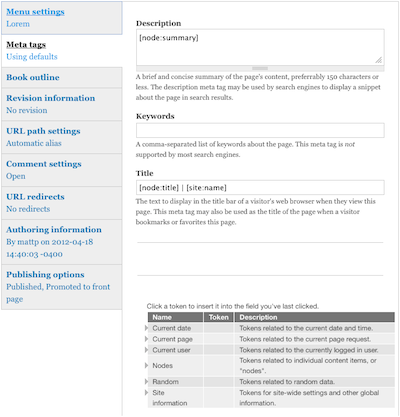Submitted by pwadmin on
 Meta tags are used to provide information summaries to search engines and web browsers, but aren't usually seen by visitors (except on pages of search results, where they are frequently displayed below the link a visitor would click on).
Meta tags are used to provide information summaries to search engines and web browsers, but aren't usually seen by visitors (except on pages of search results, where they are frequently displayed below the link a visitor would click on).
Google's Webmaster Tools article on Meta tags provides a great introduction to meta tags, which we would encourage you to read before attempting to fill in your own meta tags.
Drupal supports a large number of meta tags, but not all of them are useful for your organization. We pre-set a few of them, get Drupal to automatically fill in as many as it can. When writing or editing content, Drupal hides all but the meta tags that the writer of a page needs to see so writers are not overwhelmed.
Website users with the content administrator role have access to the same meta-tag administration page we used when setting up the site. We've pre-set the meta tags for maximum find-ability, so you shouldn't have to worry about them; but the option to customize them is available if you require it.
Adding meta tags to your page
To change meta-tags on a page:
- Go to the Meta tags section of the content form.
- Optionally, delete the contents of the Description field and write your own. By default, the description box contains "[node:summary]", which means "fill in the description with the page's summary (teaser)". This should be fine for most pages, because the summary and description usually fill the same purpose.
- Enter keywords in the keywords field. Separate them with commas and avoid repeating words (as the search engines that support the keywords meta tag penalize a page's rankings if a word is repeated).Note that entering different forms/tenses of the same word counts as repetition. For example, "eat, eaten, eating, ate" would all be considered the same word.
- Optionally, delete the contents of the Title field and write your own. The Title meta tag is shown at the top of a person's web browser, is used when bookmarking a page, and is what a user must click on in most search engine results.By default, the title box contains "[node:title] | [site:name]" which means "fill in the name of the page, add a vertical bar, and fill in the name of the site". This is a standard format for most websites, so you shouldn't change it unless your page title is really, really long.
- It's good to keep the title format consistant across every page on the site. If you want to rearrange the title (e.g.: "[site:name] | [node:title]"), change the vertical bar to something else, or similar, change it site-wide from the meta tag administration page.

